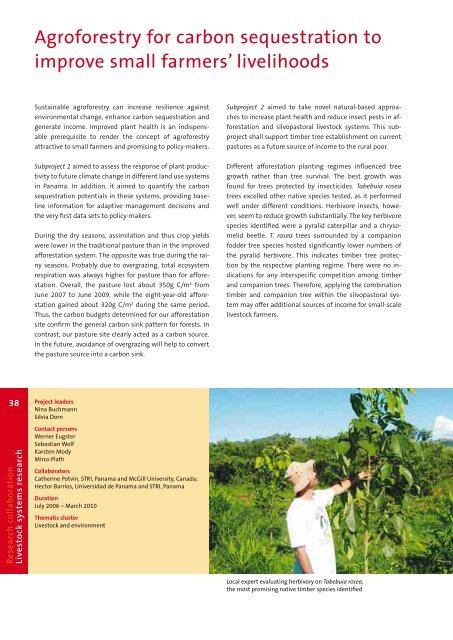NORTH-SOUTH CENTRE - ETH - North-South Centre North-South ...
NORTH-SOUTH CENTRE - ETH - North-South Centre North-South ...
NORTH-SOUTH CENTRE - ETH - North-South Centre North-South ...
Create successful ePaper yourself
Turn your PDF publications into a flip-book with our unique Google optimized e-Paper software.
Agroforestry for carbon sequestration to<br />
improve small farmers’ livelihoods<br />
Sustainable agroforestry can increase resilience against<br />
environmental change, enhance carbon sequestration and<br />
generate income. Improved plant health is an indispensable<br />
prerequisite to render the concept of agroforestry<br />
attractive to small farmers and promising to policy-makers.<br />
Subproject 1 aimed to assess the response of plant productivity<br />
to future climate change in different land use systems<br />
in Panama. In addition, it aimed to quantify the carbon<br />
sequestration potentials in these systems, providing baseline<br />
information for adaptive management decisions and<br />
the very first data sets to policy-makers.<br />
During the dry seasons, assimilation and thus crop yields<br />
were lower in the traditional pasture than in the improved<br />
afforestation system. The opposite was true during the rainy<br />
seasons. Probably due to overgrazing, total ecosystem<br />
respiration was always higher for pasture than for afforestation.<br />
Overall, the pasture lost about 350g C/m² from<br />
June 2007 to June 2009, while the eight-year-old afforestation<br />
gained about 320g C/m² during the same period.<br />
Thus, the carbon budgets determined for our afforestation<br />
site confirm the general carbon sink pattern for forests. In<br />
contrast, our pasture site clearly acted as a carbon source.<br />
In the future, avoidance of overgrazing will help to convert<br />
the pasture source into a carbon sink.<br />
Subproject 2 aimed to take novel natural-based approaches<br />
to increase plant health and reduce insect pests in afforestation<br />
and silvopastoral livestock systems. This subproject<br />
shall support timber tree establishment on current<br />
pastures as a future source of income to the rural poor.<br />
Different afforestation planting regimes influenced tree<br />
growth rather than tree survival. The best growth was<br />
found for trees protected by insecticides. Tabebuia rosea<br />
trees excelled other native species tested, as it performed<br />
well under different conditions. Herbivore insects, however,<br />
seem to reduce growth substantially. The key herbivore<br />
species identified were a pyralid caterpillar and a chrysomelid<br />
beetle. T. rosea trees surrounded by a companion<br />
fodder tree species hosted significantly lower numbers of<br />
the pyralid herbivore. This indicates timber tree protection<br />
by the respective planting regime. There were no indications<br />
for any interspecific competition among timber<br />
and companion trees. Therefore, applying the combination<br />
timber and companion tree within the silvopastoral system<br />
may offer additional sources of income for small-scale<br />
livestock farmers.<br />
38 Project leaders<br />
Nina Buchmann<br />
Silvia Dorn<br />
Research collaboration<br />
Livestock systems research<br />
Contact persons<br />
Werner Eugster<br />
Sebastian Wolf<br />
Karsten Mody<br />
Mirco Plath<br />
Collaborators<br />
Catherine Potvin, STRI, Panama and McGill University, Canada;<br />
Hector Barrios, Universidad de Panama and STRI, Panama<br />
Duration<br />
July 2006 – March 2010<br />
Thematic cluster<br />
Livestock and environment<br />
Local expert evaluating herbivory on Tabebuia rosea,<br />
the most promising native timber species identified
















